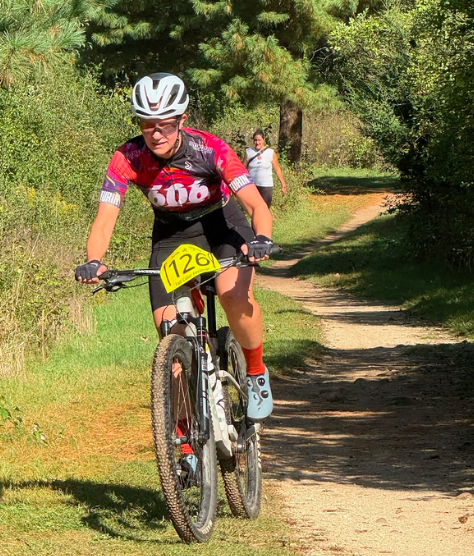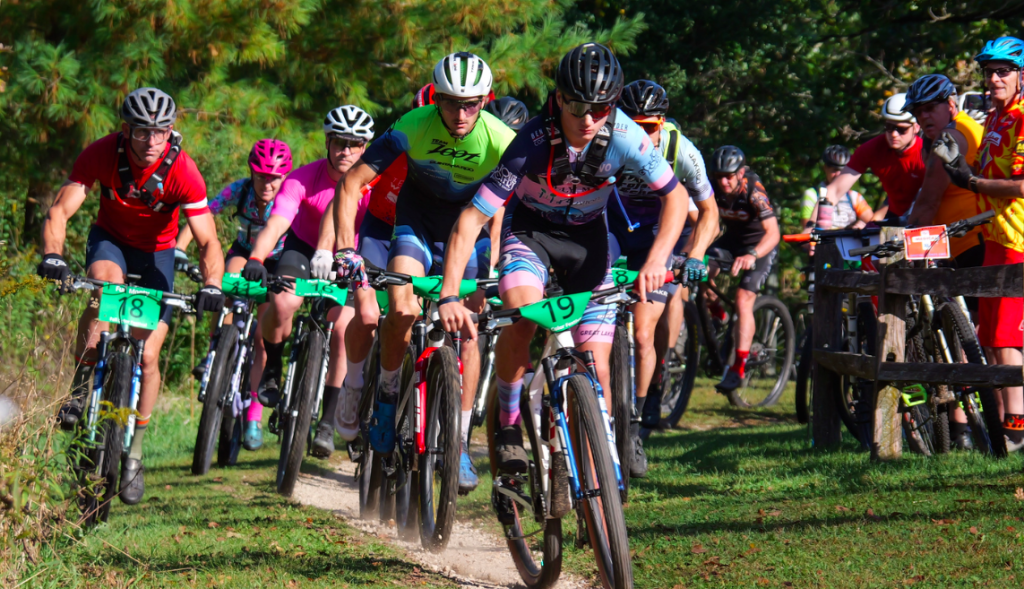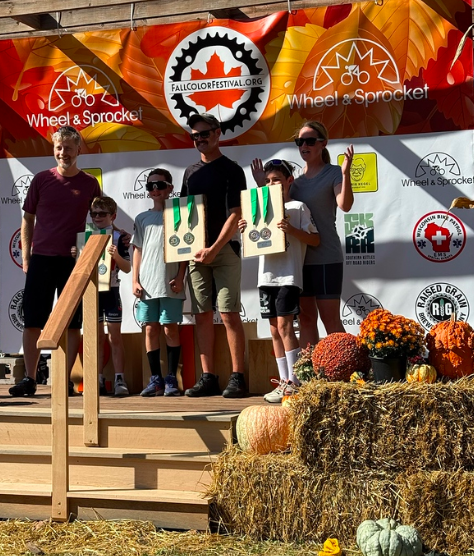The Premier MTB Race in Wisconsin’s Kettle Moraine State Park
The Annual Fall Color Festival MTB race takes place in the Southern Unit of Wisconsin’s Kettle Moraine State Forest, covering up to 32 miles of single-track across two trail systems – The John Muir, the Emma Carlin, and the 5-mile-long connector. There are several race categories depending on skill level and ambition, the most popular being the Tour de Muir, which is 18 miles and covers every section of the John Muir, but Tailwind’s intrepid race reporter did “The Full Monty” which is the premier race that covers the most land.

Terrain:
If you’re a Chicagoland mtb’r and haven’t ridden the Southern Unit trails, well, you should. No other trails within a day trip of Chicago offer this level of challenge, remoteness, elevation, or natural beauty. The Kettle Moraine was created some 10,000 years ago as the wrestling mat for a collision of two ice sheets. When they crashed, they dumped millions of tons of rocks and debris, and as they receded they left buried ice cubes that melted to create large craters, or kettles. While the rocks, and sand, and steep drop offs are terrible for agriculture (just ask my ancestors) they make a playground for mountain bikes. For the Full Monty race, we climbed a half-mile vertical and descended just as much, jumping century-old tree roots and skittering over the snaking rock gardens left by ancient glacial streams. There are multi-acre-wide sand pits too, covered by a couple inches of topsoil, making line choice a matter of survival. Riding in the sand is nearly impossible for more than a few minutes, but riding on the topsoil will force your handlebars to clip trees, but by carving the compressed sand in between, you can manage a smooth, efficient line.

Equipment:
While there are categories for fat bikes and single-speeds, everybody racing the Full Monty rode cross country mountain bikes, and mostly full suspension. Nobody in the lineup had more than 130mm of suspension travel. In 2023 I raced the Tour de Muir on an all-mountain full-sus with 140mm of rear travel, and regretted it deeply. All that unnecessary shock absorption adds weight, raises the center of gravity, and sucks energy from the rider. This year I chose the 2025 Santa Cruz Highball GX AXS, which is a hardtail. I actually bought this bike specifically for the Fall Color Festival because it’s designed for long-distance, high intensity races where energy conservation is a must. It turned out to be the correct choice, I don’t think I would have finished within the time limit on the types of all-mountain rigs I’m usually drawn to.
I was worried that – being a hardtail – the Highball would give me a spine compression disorder from all the bumps and shocks, but no. On other hardtails I get back issues on long rides from constantly having to brace and stabilize, but after many seated hours grinding sand, rocks, and roots, the 27.2mm seatpost coupled with a compliant-by-design rear triangle had me no worse off than I would be riding Chicago streets on my road bike. I could not be happier with my bike choice for another reason: two water bottles inside the triangle. With race day temperatures near 80, I stopped twice to refill my bottles and drained my hydration pack.
Two useful add-ons to the stock Highball are the fork lockout and a dropper post. Ascents and descents in the Southern Unit are sharp and technical – think lots of rocks and roots with no clear line choice. It’s handy to have the front end stay still while lining up a burst of power. On the descents, the washed-out tree roots and boulders provide many opportunities to launch over your handlebars, so getting the saddle out of the way with my Thomson dropper post helped lower my center of gravity and keep me over the pedals. I also really appreciated the Sram GX AXS group because as my body entered revolt towards the end of the race, every shift hit perfectly, so I could yell at my legs, “look, I gave you a lower gear. Happy? What else do you want from me?!”
How It Went:
Not great, honestly. Start to finish took just under 4 hours. By the time I finished the Emma Carlin leg and headed back up the connector to John Muir, the race leaders were already sitting in the beer tent – an hour-and-a-half time difference. I can only blame myself, as my training schedule consisted of commuting from Albany Park to Downtown 3 days a week and occasionally riding Paul Douglass on the odd day off. Thanks to the excellent volunteer marshals I had plenty of water and food, but with my heartrate pinned for four hours I could barely digest any of it, and suffered energy spikes and drops in the last half. My upper-body gave out before my lower-body or back, I think because the PSI in my shock and front tire were a smidge too high so my arms pumped a bit harder than necessary. Still, the only parts of the race that I really remember clearly are those intense bits in the pain cave, where I focused on things like yellow and purple wildflower blooms and bucolic vistas at the top of each ridge – anything to keep my mind off the agony in my forearms and shoulders. Tip to all cyclists out there, especially fellow roadies: don’t skip arm day.
Still, I had no crashes, only put my foot down a handful of times, and only walked one section, which was the final switchback before the peak of the Emma Carlin scenic overlook where I slipped on the gravel at 30% grade and thought to hell with this.
52 started, 49 finished, and three of the finishers stated “Chicago” as their base. Shout out to top Chicago finisher John Lee in 17th overall – way to represent the hometown! I saw two of the DNFers walking back, both had mechanicals: one broken derailleur and one flat tire. Disappointing for sure, but at least there were no injuries – though one of my fellow Chicagoans complained of some very bad cramps.

Post-race:
In the pit they put up a taco truck, BBQ, baked goods, and beer that anybody who still had an appetite could enjoy, accompanied by DJ music and kids dancing. I missed most of that and the award ceremony as I was too busy keeping the solid mass of undigested GU in my stomach from escaping. The guy who finished just before me lost that battle and let rip in the grass next to his truck. “Oh don’t worry, happens every year” he said with a chuckle. Elsewhere in the parking lot one of the top finishers was already on his third beer, and offered me one that I couldn’t accept in my sorry state, even though according to him, “it’s formulated for recovery.”
After about a half hour I got over myself, ate a couple tacos, and swapped stories with the other finishers still milling about the parking lot. A lot of my fellows have years of experience in the Kettle Moraine, one said he remembers when riding here was illegal, but they did it anyway. Another told me he lied about his age so he could race with the adults. I got to share that for me, this race is the culmination of a decade of preparation. I first found the trails in 2015 while working nearby. After moving from rural Iowa to Chicago I thought I’d never ride singletrack again, but the worksite had an old single-speed with an elastomer suspension fork that was just enough to get me down the trail. In 2017 I planned to race the Full Monty, but dislocated my shoulder on a training ride two weeks before. Then kids and work and life got in the way so I never had time to plan anything bigger than the Tour de Muir, but here in 2025 the right mix of time and energy gave me an opening to finally compete in the big race. I didn’t set any course records, but I finished the hardest day of cycling in my life with no regrets.
